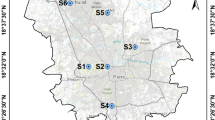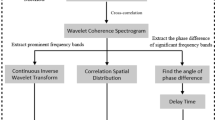Abstract
Objective
This study investigates the temporal variability of particulate matter (PM10 and PM2.5) concentrations at an inland tropical coastal site in Thiruvananthapuram (8.5°N, 76.9°E), which is in the province of Kerala in the southern part of India.
Method
Continuous measurements of PM10 and PM2.5 were carried out with high resolution datasets from March 2014 to February 2016. Variations of PM10 and PM2.5 concentrations were statistically analyzed. The conditional bivariate probability function analysis, coherence wavelet transform and HYSPLIT back trajectory model are used for this study.
Results
The annual mean mass concentrations of PM10 and PM2.5 were 44.5 ± 14.6 and 27.7 ± 10 µg m−3, respectively, for March 2014 to February 2015. Similarly, in March 2015 to February 2016, the concentrations were 40.3 ± 11.9 and 24.4 ± 7.8 µg m−3, respectively, for PM10 and PM2.5. Both concentrations exhibited higher values during winter and lower values during monsoon. The coarse particle concentration (PM10–PM2.5) during the study period was 17.38 ± 3.64 µg m−3. The mean PM2.5/PM10 ratio was found to be 0.56 ± 0.13 µg m−3 , which varied from 0.05 to 0.99 in March 2014–February 2015, and in March 2015–February 2016 it varied from 0.03 to 0.99 with a mean of 0.54 ± 0.08 µg m−3. Diurnal analysis revealed that the concentrations were higher during morning (~08:00 IST) and evening (~20:00 IST) and low during 12:00 IST–17:00 IST. The anthropogenic activities, the diurnal variation of boundary-layer height and the effects of meteorological parameters are the major elements for these variations. The effects of meteorological parameters on particulate matter were studied, and a negative correlation was observed with wind speed, rainfall, and relative humidity. The relationship between particulate matter and rainfall was investigated by applying coherence wavelet transform. The bivariate analysis showed that high PM2.5 concentrations were associated with low wind speeds indicating the presence of local pollutants. The highest concentrations were found for PM10 with moderate to strong winds, which represent the presence of local emissions. as well as long-range transport. The conditional bivariate probability function analysis was performed to identify the probability of source contributions to PM concentrations at different wind speed and direction. The results indicated that the highest probability to get high concentrations of PM from south-southwest direction with wind speed <5 ms−1. HYSPLIT model back-trajectories of high PM10 episodes show two dominant streamlines, one originating from the Bay of Bengal region and another from Middle East Asia.











Similar content being viewed by others
References
Ashbaugh LL, Malm WC, Sadeh WZ (1985) A residence time probability analysis of sulfur concentrations at Grand Canyon National Park. Atmos Environ 19(8):1263–1270. doi:10.1016/0004-6981(85)90256-2
Balakrishnaiah G, Kumar KR, Reddy BSK, Gopal KR, Reddy RR, Reddy LSS, Narasimhulu K, Ahammed YN, Balanarayana C, Moorthy KK, Babu SS (2011) Characterization of PM, PM10, PM2.5 mass concentrations at a tropical semi-arid station in Anantapur, India. Indian J Radio Space Phys 40:95–104
Beckett KP, Freer PH, Taylor G (1998) Urban woodlands: their role in reducing the effects of particulate pollution. Environ Pollut 99:347–360. doi:10.1016/S0269-7491(98)00016-5
Byrne M, Jennings SG (1993) Scavenging of submicrometre aerosol particles by water drops. Atmos Environ 27A:142099–142133. doi:10.1016/0960-1686(93)90039-2
Carslaw DC, Ropkins K (2012) Openair—an R package for air quality data analysis. Environ Model Softw 27–28:52–61. doi:10.1016/j.envsoft.2011.09.008
DeGaetano AT, Doherty OM (2004) Temporal, spatial and meteorological variations in hourly PM2.5 concentration extremes in New York City. Atmos Environ 38:1547–1558. doi:10.1016/j.atmosenv.2003.12.020
Dumka UC, Kaskaoutis DG, Srivastava MK, Devara PCS (2015) Scattering and absorption properties of near-surface aerosol over Gangetic-Himalayan region:the role of boundary-layer dynamics and long-range transport. Atmos Chem Phys 15:1555–1572. doi:10.5194/acp-15-1555-2015
Eatough DJ, Long RW, Modey WK, Eatough NL (2003) Semi-volatile secondary organic aerosol in urban atmospheres: meeting a measurement challenge. Atmos Environ 37:1277–1292. doi:10.1016/S1352-2310(02)01020-8
Elminir HK (2005) Dependence of urban air pollutants on meteorology. Sci Total Environ 350:225–237. doi:10.1016/j.scitotenv.2005.01.043
Engler C, Birmili W, Spindler G, Wiedensohler A (2012) Analysis of exceedances in the daily PM10 mass concentration (50 µg m−3) at a roadside station in Leipzig, Germany. Atmos Chem Phys 12:10107–10123. doi:10.5194/acp-12-10107-2012
Exton HJ, Latham J, Park PM, Perry SJ, Smith MH (1985) The production and dispersal of marine aerosol. Q J R Metereol Soc 111:817–837. doi:10.1002/qj.49711146909
Flossmann FI, Hall WD, Pruppacher HR (1985) A theoretical study of the wet removal of atmospheric pollutants: Part I. The redistribution of aerosol particles captured through nucleation and impaction scavenging by growing cloud drops. J Atmos Sci 42:583–606. doi:10.1175/1520-0469(1985)042<0583:ATSOTW>2.0.CO;2
Hall JV (1966) Assessing health effects of air pollution. Atmos Environ 3:743–746. doi:10.1016/1352-2310(95)00014-3
Hanel G (1976) The properties of atmospheric aerosol particles as functions of the relative humidity at thermodynamic equilibrium with the surrounding moist air. Adv Geophys 19:73–188. doi:10.1016/S0065-2687(08)60142-9
Jaenicke R (1984) Physical aspects of atmospheric aerosol. In: Gerbard HE, Deepak A (eds) Aerosols and their climatic effects. Deepak Publishing, Hampton, pp 7–34
Jayamurugan R, Kumaravel B, Palanivelraja S, Chockalingam MP (2013) Influence of temperature, relative humidity and seasonal variability on ambient air quality in a coastal urban area. Int J Atmos Sci. doi:10.1155/2013/264046
Jayaraman G, Kumari S, Goel M (2007) Seasonal variation and dependence on meteorological condition of roadside suspended particles/pollutants at Delhi. Environ Sci 2:130–138
Jin X, Dubois D, Pitchford M, Green M, Etyemezian V (2006) Attribution of sulfate aerosols in Federal Class I areas of the western United States based on trajectory regression analysis. Atmos Environ 40:3433–3447. doi:10.1016/j.atmosenv.2006.02.009
Kothai P, Prathibha P, Saradhi IV, Pandit GG, Puranik VD (2009) Characterization of atmospheric particulate matter using PIXE technique. Int J Environ Chem Ecol Geol Geophys Eng 3:39–41
Kunhikrishnan PK, Gupta KS, Ramachandran R, Prakash WJ, Nair KN (1993) Study on thermal internal boundary layer structure over Thumba. India Ann Geophys 11:52–60
Lakshmi V, Piechota T, Narayan U, Tang C (2004) Soil moisture as an indicator of weather extremes. Geophys Res Lett 31:L11401. doi:10.1029/2004GL019930
Latha KM, Badarinath KVS (2005) Seasonal variations of black carbon aerosols and total aerosol mass concentrations over urban environment in India. Atmos Environ 39:4129–4141. doi:10.1016/j.atmosenv.2005.04.004
Li M, Huang X, Lei Z, Li J, Song Y, Cai X, Xie S (2012) Analysis of the transport pathways and potential sources of PM10 in Shanghai based on three methods. Sci Total Environ 414:525–534. doi:10.1016/j.scitotenv.2011.10.054
Pillai PS, Moorthy KK (2001) Aerosol mass-size distributions at a tropical coastal environment: response to mesoscale and synoptic processes. Atmos Environ 35:4099–4112. doi:10.1016/S1352-2310(01)00211-4
Pillai PS, Babu SS, Moorthy KK (2002) A study of PM, PM10 and PM2.5 concentrations at a tropical coastal station. Atmos Res 61:149–167. doi:10.1016/S0169-8095(01)00136-3
Pruppacher HR, Klett JD (1978) Micophysics of clouds and precipitation. Reidal Publishing, Boston
Ragi MS, Muralidharan V, Sukumar N, Sha APN (2013) Short-term assessment of FPM concentration in the urban and rural ambient air environments of an Indian tropical area at Thiruvananthapuram, Kerala. Int J Geol Earth Environ Sci 3:52–60
Saha A, Despiau S (2009) Seasonal and diurnal variations of black carbon aerosols over mediterranean coastal zone. Atmos Res 92:27–41. doi:10.1016/j.atmosres.2008.07.007
Sarkar C, Chatterjee A, Singh AK, Ghosh SK, Raha S (2015) Characterization of black carbon aerosols over Darjeeling—a high altitude Himalayan station in eastern India. Aerosol Air Qual Res 15:465–478. doi:10.4209/aaqr.2014.02.0028
Satsangi PG, Kulshrestha A, Taneja A, Rao PSP (2011) Measurements of PM10 and PM2.5 Aerosols in Agra, a semi-arid region of India. Indian J Radio Space Phys 40:203–210
Schwartz J, Dockery DW, Neas LM (1996) Is daily mortality associated specifically with fine particles? J Air Waste Manag Assoc 46(10):927–939. doi:10.1080/10473289.1996.10467528
Shaharuddin M, Mohd A, Mohd J, Othman N, Karim A, Sopian K (2008) Application of wavelet transform on airborne suspended particulate matter and meteorological temporal variations. WSEAS Trans Environ Dev 4(2):89–98
Sharma M, Maloo S (2005) Assessment of ambient air PM10 and PM2.5 and characterization of PM10 in the city of Kanpur, India. Atmos Environ 39:6015–6026. doi:10.1016/j.atmosenv.2005.04.041
Sivaramasundaram K, Muthusubramanian P (2010) A preliminary assessment of PM10 and TSP concentrations in Tuticorin, India. Air Qual Atmos Health 3:95–102. doi:10.1007/s11869-009-0055-x
Stull R (1988) An introduction to boundary layer meteorology. Springer, New York
Tiwari S, Bisht DS, Srivastava AK, Pipal AS, Taneja A, Srivastava MK, Attri SD (2014) Variability in atmospheric particulates and meteorological effects on their mass concentrations over Delhi, India. Atmos Res 146:45–56. doi:10.1016/j.atmosres.2014.03.027
Uria-Tellaetxe I, Carslaw DC (2014) Conditional bivariate probability function for source identification. Environ Model Softw 59:1–9. doi:10.1016/j.envsoft.2014.05.002
Vijayakumar G, Paramesewaran K, Rajan R (1998) Aerosols in the atmospheric boundary layer and its association with surface wind speed at a coastal site. J Atmos Sol Terr Phys 60:1531–1542. doi:10.1016/S1364-6826(98)00093-5
Wilson WE, Suh HH (1997) Fine particles and coarse particles: concentration relationships relevant to epidemiologic studies. J Air Waste Manag Assoc 47(12):1238–1249. doi:10.1080/10473289.1997.10464074
World Health Organization (2000) Air quality guide-lines for Europe, No. 91, 2nd edn. WHO Regional Publications European Series, Kopenhagen
World Health Organization (2003) Health aspects of air pollution with particulate matter, ozone and nitrogen dioxide report on a WHO Working Group. World Health Organization, Bonn, pp 13–15
Yamagata S, Kobayashi D, Ohta S, Murao N, Shiobara M, Wada M, Yabuki M, Konishi H, Yamanouchi T (2009) Properties of aerosols and their wet deposition in the arctic spring during ASTAR2004 at Ny-Alesund, Svalbard. Atmos Chem Phys 9:261–270. doi:10.5194/acp-9-261
Yu Y, Schleicher N, Norra S, Fricker M, Dietze V, Kaminski U, Cen K, Stuben D (2011) Dynamics and origin of PM2.5 during a three-year sampling period in Beijing, China. Environ Monit 13:334–346. doi:10.1039/c0em00467g
Acknowledgements
The authors are grateful to the project director, Modelling Atmospheric Pollution and Networking, Indian Institute of Tropical Meteorology for identifying Thiruvananthapuram as a MAPAN station. Also, we sincerely acknowledge the support of the Ministry of Earth Sciences, Government of India, for providing grants with the project entitled as MAPAN-13. We also acknowledge with thanks to Dr. T. N. Prakash, Senior Scientist, NCESS; Dr. K. K Ramachandran, Group head, AtP and Director, NCESS for providing support and continued encouragement. The authors gratefully acknowledge the NOAA Air Resources Laboratory (ARL) for the provision of the HYSPLIT transport and dispersion model and data. MERRA data is available from NASA Goddard Earth Sciences Data and Information Services Centre. We thank the editor and anonymous reviewers for their constructive comments, which helped us to improve the manuscript.
Author information
Authors and Affiliations
Corresponding author
Rights and permissions
About this article
Cite this article
Sumesh, R.K., Rajeevan, K., Resmi, E.A. et al. Particulate Matter Concentrations in the Southern Tip of India: Temporal Variation, Meteorological Influences, and Source Identification. Earth Syst Environ 1, 13 (2017). https://doi.org/10.1007/s41748-017-0015-9
Received:
Revised:
Accepted:
Published:
DOI: https://doi.org/10.1007/s41748-017-0015-9




